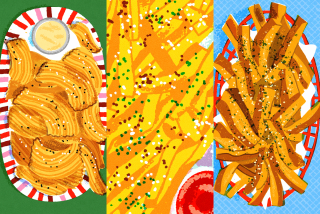The Rice You Can Dip Into Catsup
- Share via
Cutting the fat in French fries by half would be a nice touch for millions of junk-food fans. Make that a rice touch.
Food technologists have developed a French fry that looks like the real thing, delivers 25% to 50% less fat and consists mainly of rice.
The bad news is that it tastes like rice, not like a French-fried potato.
But that can be fixed, says Ranjit Kadan, a food technologist with the Agricultural Research Service at the Southern Regional Research Center in New Orleans.
“The thing to remember is rice has a very mild taste, and you can flavor it with onions, spices or anything,” Kadan says. “Since we are starting with rice flour, we can fortify it with protein, vitamins and minerals to make an even more nutritious, wholesome food.”
Rice is part of the bread and cereal food group that federal guidelines recommend as the main staple of any diet. The guidelines encourage consumers to get less than 30% of their daily calories from fat.
The Agriculture Department outlines how rice fries could be made:
After water is added to fine rice flour, the mixture is extruded through a screw-type machine and molded into conventional French-fry shape, much as commercial breakfast cereals are formed. The fries would probably be cooked like regular French fries: fried in oil at the factory and shipped frozen to consumers for reheating in a microwave or conventional oven.
When fried, the snack is crispy on the outside and fluffy white on the inside.
Kadan is uncertain why rice fries are lower in fat but suggests it could be because of subtle differences in the chemistry of rice and potatoes.
No commercial production process has been developed. But food processor Rishellco Inc. of Crowley, La., is looking into manufacturing the new product.
Agriculture sees a bonus for farmers if rice fries catch on.
Rice growers have to sell broken kernels at a lower price--about 7 cents a pound compared with up to 24 cents for whole rice. Converting broken kernels into a new snack food would open new markets for grain growers.
More to Read
Eat your way across L.A.
Get our weekly Tasting Notes newsletter for reviews, news and more.
You may occasionally receive promotional content from the Los Angeles Times.










